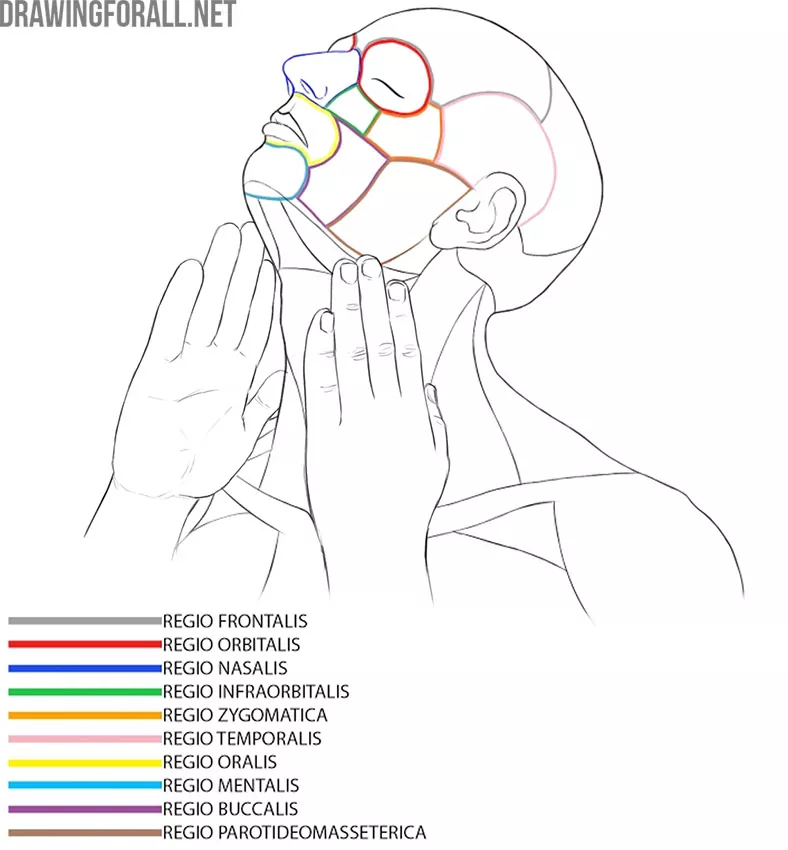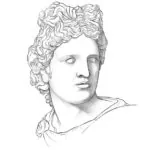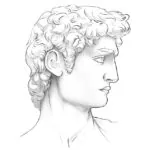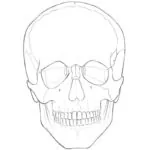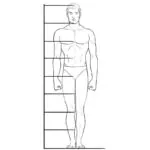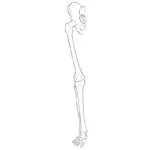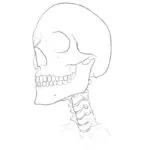Head Muscles Anatomy
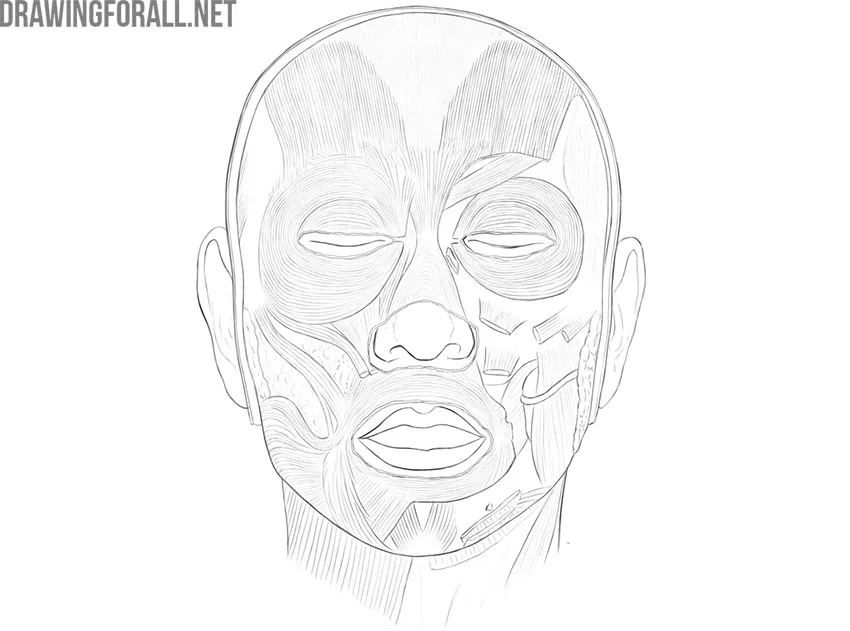
The muscles of the head are divided into two large groups – the mimic muscles and the muscles of mastication. The main functions of the mimic muscles are the transmission of emotions through facial expressions, as well as participation in defensive reactions, such as blinking or sneezing. The main function of the muscles of mastication is to move the lower jaw to grind food.
The mimic muscles have some features. As you know, bones are the attachment points for common skeletal muscles. The muscle attaches to the bone, usually near the closest joint. When contracting, the muscle acts on the bone sets in motion the nearest joint, and as a result, we see the movement of the bone.
Mimic muscles, unlike other skeletal muscles, attach directly to the skin of the face and set in motion the skin of the face.
Another feature of the facial muscles is the absence of fascia. Fasciae are dense connective tissue membranes that cover almost all of the human skeletal muscles. If you love to cook meat, you have probably seen dense white films that are located on muscle fibers – these are fascia. The facial muscles are completely devoid of the fascia.
Finally, one more feature concerns the topography of the mimic muscles. The mimic muscles are located around the natural openings of the head, such as the mouth, nose, ears, and orbital borders.
Let’s look at the main mimic muscles of a human.
Epicranius Muscle
The epicranius muscle is the largest facial muscle. This muscle has two parts – the frontal part and the occipital part. Both parts of the muscle connect to a dense tendon plate called a galea aponeurotica.
The frontal part starts from the supracranial aponeurosis and attaches to the skin above the eyebrows. That is why we attribute the epicranius muscle to the mimic muscles of the face. The occipital part extends from the superior nuchal line of the skull to the posterior part of the supracranial aponeurosis.
Function: the occipital part slightly pulls the scalp to its side, and the frontal part pulls the scalp to its side. When fixing the supracranial aponeurosis, the contraction of the frontal abdomen raises the eyebrows.
Orbicularis Oculi
It is a large, prominent muscle that surrounds the eye. The orbicularis oculi are divided into three parts: the orbital part, the palpebral part, and the lacrimal part.
The orbital part is located around the orbit. This is the largest part, it, in fact, surrounds all the rest of the circular muscle of the eye. When contracted, this muscle strains the skin around the eye and squeezes it tightly.
The palpebral part forms the muscle base for the eyelids. These muscles contract and close the eyes.
The lacrimal part is very small, and it is rather difficult to notice it without good preparation. The lacrimal part is involved in the removal of tear fluid from the eye during crying.
Procerus Muscle
It is a small rectangular muscle located between the eyes on the bony base of the nose. As it contracts, the muscle compresses the skin above and between the eyes. This creates a frowned expression with noticeable vertical folds between the eyes.
Nasalis Muscle
The nasalis muscle has two parts. The transverse part is located outside. This part covers the wings of the nose from the outside, diverging laterally and passing into the tendon.
We can only see the wing part if we use a special dissection technique because the wing part goes around the wings of the nose from the inside and attaches to the nasal cartilage.
Both parts of the nasalis muscle work together to contract the wings of the nose so as to narrow the nostrils slightly.
Orbicularis Oris Muscle
Like many mimic muscles, the orbicularis oris muscle is divided into two parts. In this case, we have the labial part and the marginal part. The labial part is actually the lips, which we can see directly on a living person. The marginal part is more rounded and surrounds the labial part.
When contracted, the marginal part pulls out the lips like a tube, and the lip part tightly closes the lips.
Buccinator Muscle
The buccinator muscle is quite large, it is slightly overlapped by the muscles of mastication (we will discuss it soon), the zygomatic muscles, and is completely overlapped by the buccal fat pad. This formation of adipose tissue is especially noticeable in infants and overweight people.
The buccal muscle during bilateral contraction (that is when both the left and right muscles are working) presses the cheeks to the teeth, pulling them inward; during unilateral contraction, the muscle pulls the corner of the mouth laterally.
Zygomaticus Major and Zygomaticus Minor
These two muscles are fairly easy to find, as they both start from the anterior surface of the zygomatic bone. These muscles have a similar shape and are quite close to each other. To distinguish them, you need to remember that the small zygomaticus minor muscle is located closer to the nose.
The zygomaticus major muscle is woven into the circular muscle of the mouth, and the zygomaticus minor muscle is connected to the skin in the area of the nasolabial fold.
Both muscles work almost synergistically to perform similar functions. The zygomaticus major muscle pulls the corners of the lips upward and laterally. The zygomaticus minor muscle pulls the corners of the lips also upward, outlining the contours of the nasolabial fold. The result is a grin-like expression on the upper lip.
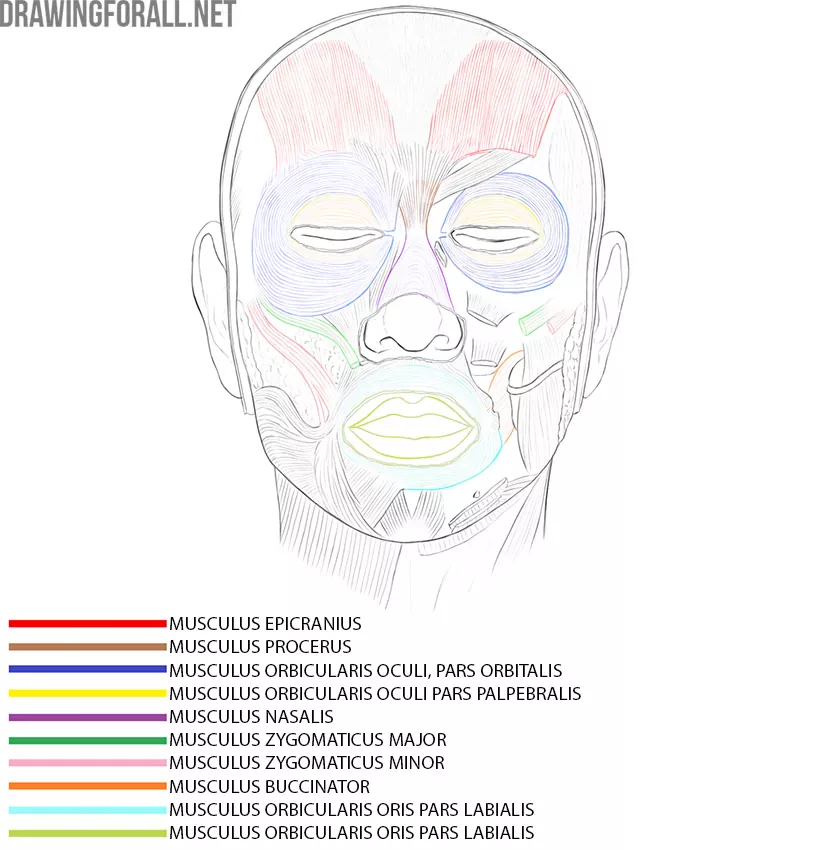
Muscles of Mastication
The muscles of mastication are large, powerful, and essential for nutrition and survival. A person has four pairs of masticatory muscles, of which two are of particular importance for plastic anatomy because they are involved in the formation of the contour of the face.
Temporalis Muscle
The temporalis muscle is very large, flat, fills the entire temporal fossa. Unlike the rest of the masticatory muscles, the temporalis muscle is located on the vault of the skull. This muscle starts from several bones at once – the temporal, frontal, parietal, and pterygoid.
Multiple muscle bundles converge downward and centrally, forming a powerful tendon that attaches to the coronoid process of the mandible.
You can feel the contraction of the temporalis muscle if you place your fingers on the temporal fossa and clench your teeth several times to simulate chewing.
Masseter Muscle
This is also a powerful and highly visible muscle. The chewing muscle contours through the skin at the time of contraction, especially in lean people.
Both parts of the masticatory muscle are directed diagonally posteriorly, attaching to the masticatory tuberosity of the lower jaw.
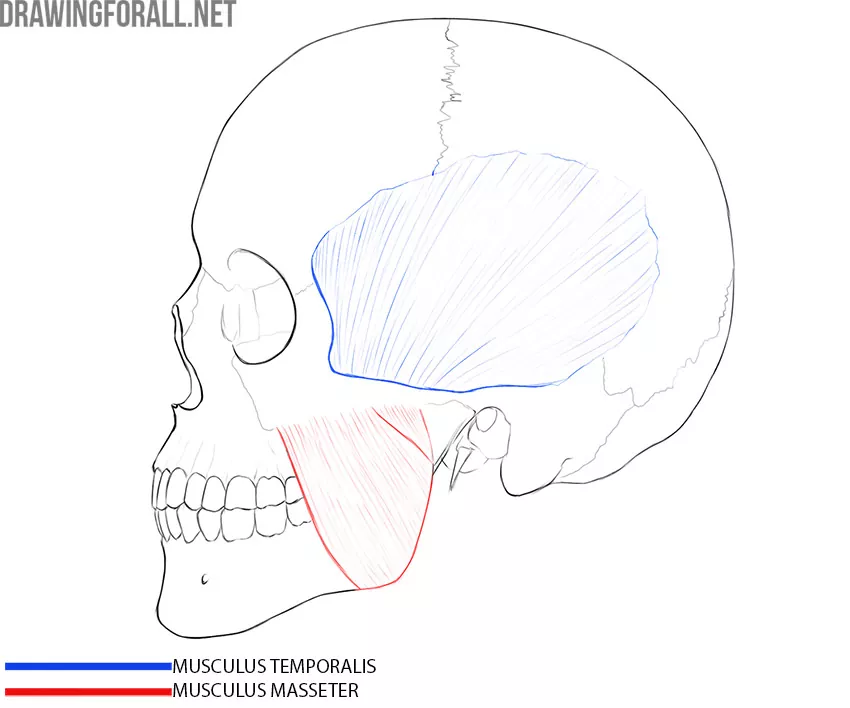
Basic Topography of the Head
In topographic anatomy, body parts are studied, not organ systems. For example, today we will be looking at basic head topography. This is not only the skull but also the muscles of the head and other anatomical formations that form important landmarks in plastic anatomy.
Head Borders
To draw the line that separates the head and neck, we need to draw a line from the chin along the lower edge of the lower jaw, then go to the mastoid process and finish at the lower occipital protuberance.
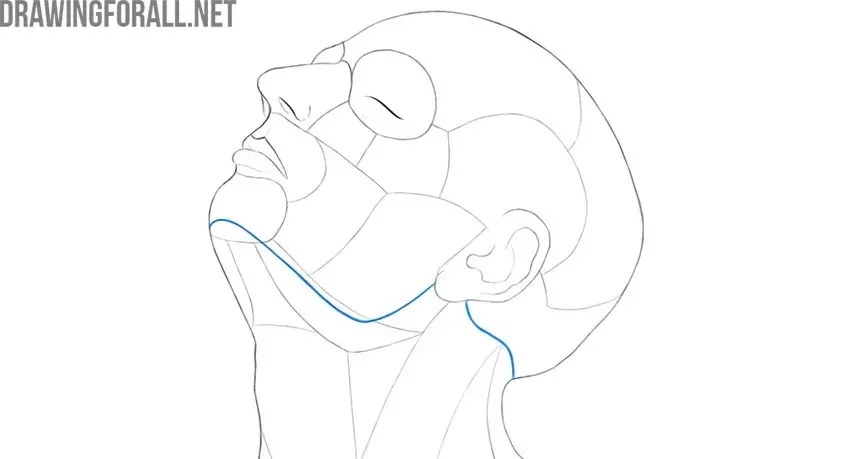
Cerebral and Facial Parts of the Head
The skull makes up the skeleton of the head, so the boundaries of the facial and cerebral parts of the skull coincide with the boundaries of the facial and cerebral parts of the head.
So, in order to draw the border between the cerebral and facial parts of the head, we need to draw a line from the brow arches, then go down and go along the zygomatic arch towards the back of the head. After that, from the zygomatic arch, we continue the line to the upper edge of the external auditory canal.
So we got a line that separates the cerebral and facial sections of the head.
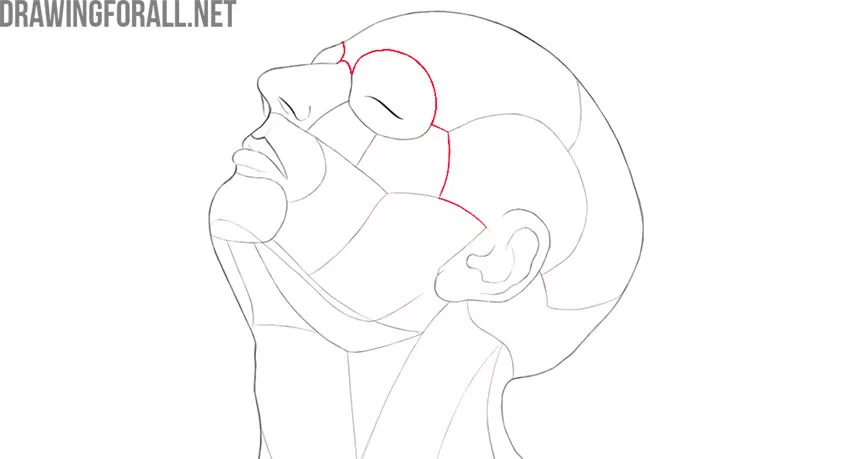
Head Regions
Determining the boundaries of areas is a fundamentally important task of topographic anatomy. To study the regions of the head, we must be able to clearly separate the cerebral and facial parts of the head.
Areas of the Cerebral Section of the Head
On the cerebral part of the head, we can see three areas – the fronto-parieto-occipital region, the temporal, and mastoid. The frontal-parietal-occipital region is unpaired, the other two areas are paired.
The frontal-parietal-occipital regions are bordered:
⦁ In front – with orbital edges of the frontal bone;
⦁ Behind – with the upper neck line;
⦁ Laterally – with the superior temporal line of the parietal bone.
The temporal region is bordered:
⦁ In front – with the zygomatic process of the frontal bone and the frontal process of the zygomatic bone;
⦁ Behind – with the temporal line;
⦁ Above – with the temporal line;
⦁ Below – with zygomatic arch.
Mastoid Region
The mastoid area corresponds to the boundaries of the mastoid process.
Regions of the Facial Part
Orbital Region
The boundaries of the orbital region correspond to the boundaries of the bony orbital cavity:
⦁ Upper – the orbital edge of the frontal bone;
⦁ Lower – infraorbital edge of the upper jaw and the adjacent zygomatic bone;
⦁ Lateral – zygomatic bone;
⦁ Medial – the frontal process of the upper jaw and the nasal part of the frontal bone.
Nose Region
The boundaries of the nasal region correspond to the contours of the outer part of the nose, which consists of the back, root, apex, and wings.
Zygomatic Region
The border of the zygomatic region corresponds to the contours of the body of the zygomatic bone.
Infraorbital Region
The infraorbital region borders:
⦁ Laterally and behind the with the zygomatic region;
⦁ Medial – with the nasal region;
⦁ Above – with the orbital region;
⦁ Bottom – with cheek area.
Buccal Region
The buccal region borders:
⦁ Medial – with the nasolabial furrow;
⦁ Laterally – with the parotid-masticatory area;
⦁ Bottom – with the lower edge of the lower jaw;
⦁ Above – with the zygomatic and infraorbital areas.
Mouth Region
The mouth area is bordered:
⦁ Above – with the new area;
⦁ Below – with the chin area;
⦁ Laterally on both sides – with the buccal areas.
Chin Region
The chin is bordered:
⦁ Above – with the area of the mouth;
⦁ Laterally on both sides – with the buccal areas;
⦁ Bottom – with the lower edge of the lower jaw.
Parotid Masseteric Region
Parotid masseteric region borders:
⦁ Above – with the infraorbital region of the facial region and the temporal region of the brain region;
⦁ Bottom – with the lower edge of the lower jaw;
⦁ Medial – with the buccal area;
⦁ Laterally – with the auricle.
